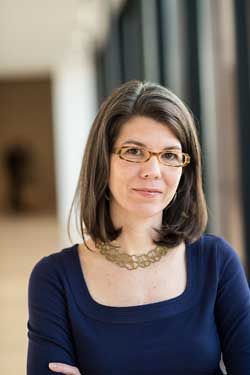A hinged flange grips an ordinary round stone; from its clasp, a ribbon of rusted steel arcs upward, culminating with a loosely attached, crusty iron bolt. The components of Untitled (Elemental Sculpture) [steel flange and stone] (ca. 1953),1 like those of many of the works in Robert Rauschenberg’s series Elemental Sculptures, suggest on first glance that the piece might once have had a useful function. Perhaps the stone hung from the steel strap as a counterweight on some primitive machine, or maybe the two parts formed a sort of mallet or weapon?2 Upon closer inspection, however, it becomes clear that the mass of the stone outweighs the delicate counterpoise of the twisted strip of steel and the bolt that dangles from its outer tip. The parts do not add up, and we are left to try to understand this curious contraption as a work of art.
Rauschenberg’s Elemental Sculptures originally numbered nineteen works, only nine of which are extant. All but two of the sculptures in the series are untitled, and all are believed to have been created in 1953.3 The Elemental Sculptures debuted in mid-1953 when a selection of them was included in a two-person exhibition featuring Rauschenberg and Cy Twombly (1928–2011) at the Stable Gallery, New York.4 The series explores the basic formal aspects of sculpture (volume, line, mass, space) with found materials such as sisal twine, square-head nails, scrap metal, stones, and weathered wooden boxes and blocks of wood. Significantly, these materials are “elemental” in nature—rough-hewn and unrefined. Through their combination, Rauschenberg created very simple compositions that are almost Brancusi-like in their spare vocabulary of forms.
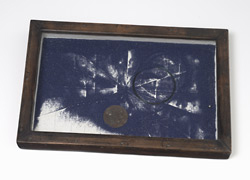
2. Joseph Cornell, Untitled [Blue Sand Tray], ca. 1950. Wood, glass, dyed sand, metal, and paper, 1 1/2 x 15 1/16 x 9 15/16 in. (3.8 x 38.3 x 25.2 cm). Collection SFMOMA, Anonymous gift; © The Joseph and Robert Cornell Memorial Foundation / Licensed by VAGA, New York, NY
Beginning in the 1910s, a number of artists—Marcel Duchamp (1887–1968), Naum Gabo (1890–1977), Alexander Calder (1898–1976), and Joseph Cornell (1903–1972),5 among others—created sculptures with variable arrangements of forms that often incorporated movable components. Cornell’s Sand Boxes and Sand Trays, for example, consist of sealed boxes filled with colored sand and bits of metal and paper that slide around inside the boxes when they are moved (fig. 2). Many of the Elemental Sculptures expand on such models by allowing the viewer (or installer) to decide how to arrange the work’s movable elements. For instance, Untitled (Elemental Sculpture) [stone and box] (ca. 1953, Estate of Cy Twombly) can be shown with the stone inside or outside the box. Other works in the series offer the opportunity to reposition tethered stones, to rearrange small piles of pebbles,6 or to pick up a box and rattle around the loose stones inside.7
Variability of sculptural elements first appeared in Rauschenberg’s work in a group of fetishistic assemblages he created while traveling in Italy and North Africa in 1952. Called Scatole Personali, these works are boxed assortments of bones, insects, feathers, string, and other small miscellanea, some of which are loose inside the container or can be removed entirely (fig. 3). In both the Scatole Personali and the Elemental Sculptures, the variability most often resides in the viewer’s ability to move or reposition isolated elements in or around a fixed base, such as a box or plank.
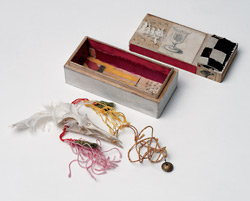
3. Robert Rauschenberg, Untitled (Scatole Personali), ca. 1952. Lidded painted wooden box with printed reproductions, paper, and fabric, containing bird skull with rhinestone, colored threads, feathers, and bell, 2 1/8 x 4 11/16 x 2 1/8 in. (5.4 x 11.9 x 5.4 cm). The Menil Collection, Houston, purchase with funds provided by Louisa Stude Sarofim; © Robert Rauschenberg Foundation / Licensed by VAGA, New York, NY
The present sculpture pushes the idea of variability a step further by virtue of the fact that the entire piece can be reoriented: it has no base, top, or bottom. The angles of the three elements—stone, strap, and bolt—can be adjusted in relation to one another: the stone and flange connect to the bent metal strip via a movable hinged joint, and an eyehole in the head of the bolt permits it to swivel in relation to the steel strap. Likewise, the stone can rest in a number of stable orientations. The sculpture can thus be completely turned on its head (or side, or back) and have its components rearranged around it. At least eight secure configurations are possible, each of them suggesting different levels of tension, motion, and stasis (fig. 4). Though the sculpture has most frequently been shown and photographed as it appears here, any of the positions were acceptable to the artist.8
4.Jess Kreglow, a member of SFMOMA’s installations team, manipulates Untitled (Elemental Sculpture) [steel flange and stone] and demonstrates different orientations in which it can be displayed.
A Hans Namuth (1915–1990) photograph taken around 1964 in Rauschenberg’s Broadway studio shows an extreme variation on the usual orientation of this sculpture (fig. 5). The stone and flange are suspended off the end of a small cabinet, and the bolt appears to be sunk into a heavy block of wood or concrete that resembles the solid bases of other works in the Elemental Sculptures series. The photo is not detailed enough to allow us to decipher the material the block is made of, or to discern exactly how the work is anchored. It is clear, however, that the block is substantial enough to support the weight of the dangling stone. The photo may show a previous state of the sculpture, or it may simply capture a quirky decision Rauschenberg made (and later abandoned) about how to display the work. Either way, the choice to suspend the rock from the cabinet suggests that, from very early on, the artist was remarkably open to its many possible orientations. One further clue about the artist’s attitude toward the changeability of this sculpture appears on the commercially produced metal flange: the word “MALLEABLE” is cast into the metal, part of its labeling as an industrial product (fig. 6). Given Rauschenberg’s propensity for exploiting the potential of found words, it cannot be purely coincidental that he salvaged this particular piece for use in a sculpture with movable parts. By encouraging the manipulation and rearrangement of the works in the series, he relinquished control and mandated a connection between the sculptures and those who would encounter them in the future.
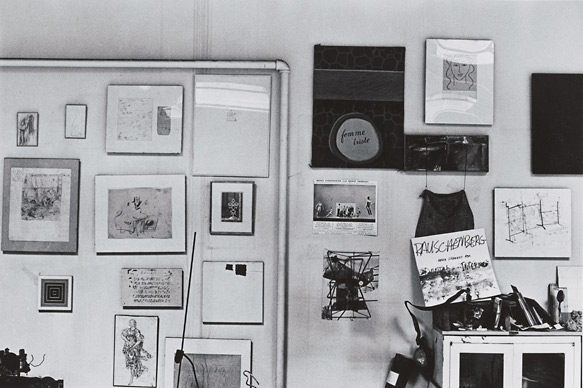
5. View of Robert Rauschenberg’s Broadway studio showing Untitled (Elemental Sculpture) [steel flange and stone] (ca. 1953) hanging off the top of the cabinet in the background, ca. 1964. Center for Creative Photography, The University of Arizona; photo: Hans Namuth; © Hans Namuth Estate, courtesy Center for Creative Photography
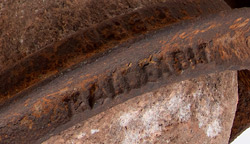
6. Detail of Robert Rauschenberg's Untitled (Elemental Sculpture) [steel flange and stone] (ca. 1953) showing the word "malleable" impressed on the steel flange
Rauschenberg’s decision to use raw, found materials in the Elemental Sculptures marks a turning point in his work. These sculptures do not share the reliquary qualities of the Scatole Personali, largely because their materials are rougher and treated with far less preciousness. While the Scatole Personali consist of romantic, nostalgic ephemera nestled in decorative boxes, the Elemental Sculptures present their materials as the artist found them. This straightforward, simple approach dignifies the sculptural elements; Rauschenberg once described the process as “renourishing something that’s been abandoned.”9 Indeed, the artist scavenged most of the materials for this series from construction sites in the neighborhood around his Fulton Street studio, noting, “The most interesting things on Fulton Street were the rocks that were dug up every day. So I made a series of rock sculptures.”10 This respect for and elevation of the humble, which became a signature emphasis of the Combines and recurred throughout Rauschenberg’s later works, first flourished in the Elemental Sculptures.
The artist’s handling of found objects in this series is no doubt indebted to surrealist and Dada precedents such as Duchamp’s assisted readymades À bruit secret (1916) and Why Not Sneeze Rose Sélavy (1921), and Rauschenberg himself has noted that he was thinking of Duchamp when he made Music Box (Elemental Sculpture) (1953).11 However, Rauschenberg inverts the Dada tactic of taking functional objects and rendering them bizarrely unusable,12 instead combining useless scraps into objects that seem somehow functional. The similarity to Dada was not lost on James Fitzsimmons, an art critic who reviewed the Stable Gallery exhibition in which the Elemental Sculptures debuted. He complained of “how dull they seem 25 years after Dada, how much less amusing than Duchamp’s objets trouvés and Man Ray’s objets inutiles.”13 Fitzsimmons read the series as a direct extension of Dada, missing a crucial turn taken by Rauschenberg. Indeed, Rauschenberg does play with the same variables as Duchamp—found materials, the precepts of art and aesthetics, the boundaries of taste—but he rearranges these variables into a new equation. Duchamp’s objects trouvés are a profoundly anti-art endeavor, offering up aesthetically unseemly, everyday objects in order to undermine the definition of art. By comparison, the Elemental Sculptures are pro-art, rehabilitating similarly unaesthetic materials and sincerely asking us to notice their lowly beauty.
Notes
- While working with curator Walter Hopps to prepare for the 1991–93 exhibition Robert Rauschenberg: The Early 1950s, the artist assigned a descriptive identifier to each of the works in the Elemental Sculptures series in order to differentiate them. The descriptors, based on the materials used in each work, are not technically part of the proper artwork titles but are commonly used in publication. The descriptions appear in brackets following Untitled and the series name, which the artist’s titling conventions include in parentheses following the primary title. Thus, the commonly cited name for this work is Untitled (Elemental Sculpture) [steel flange and stone].
- In his review of the Stable Gallery exhibition Rauschenberg: Paintings and Sculpture; Cy Twombly: Paintings and Drawings (New York, September 15–October 3, 1953), in which a number of Rauschenberg’s Elemental Sculptures appeared, art critic James Fitzsimmons noted the resemblance of one of the sculptures to “a caveman’s noggin knocker.” James Fitzsimmons, “Art,” Arts and Architecture 70, no. 10 (October 1953): 34. Carolyn Lanchner has suggested that Fitzsimmons was referring specifically to this sculpture. See Carolyn Lanchner, Robert Rauschenberg (New York: Museum of Modern Art, 2009), 12. However, Fitzsimmons describes the piece as a stone suspended from a heavy string. Untitled (Elemental Sculpture) [steel flange and stone] has never been known to have a string attached, nor has its inclusion in the Stable Gallery show been confirmed.
- The two versions of Music Box are the only works in the series with specific titles. The Elemental Sculptures that were definitively shown in the Stable Gallery exhibition (as confirmed by a series of unpublished installation views taken by Allan Grant for Life magazine) are dated 1953. Those that cannot be identified as part of the exhibition (including SFMOMA’s sculpture) are dated ca. 1953. Grant’s photos may be viewed through Getty Images in the Time & Life Pictures collection, available at https://www.gettyimages.com/creative/frontdoor/timeandlife. See, for example, key numbers 50602702, 50602703, 50602704, and 50602705.
- See note 2 for full exhibition title and dates. As stated above, Untitled (Elemental Sculpture) [steel flange and stone] is not known to have been among the works included in the Stable Gallery exhibition. Ten Elemental Sculptures are documented in the Grant photographs, but nearly all of the sculptures are no longer extant. The current location is known for just one sculpture documented by Grant: Untitled (Elemental Sculpture) [stone and box] (ca. 1953), which is in the Estate of Cy Twombly. The other nine are believed to have been lost or destroyed.
- Rauschenberg knew Cornell’s work by late 1949, and he became personally acquainted with him by 1953. See Joan Young with Susan Davidson, “Chronology,” in Robert Rauschenberg: A Retrospective, ed. Walter Hopps and Susan Davidson (New York: Solomon R. Guggenheim Museum, 1997), 552.
- For example, a small pile of pebbles in Untitled (Elemental Sculpture) [block and stones] (1953) was available for gallery visitors to rearrange. See Walter Hopps, Robert Rauschenberg: The Early 1950s (Houston: Menil Foundation, 1991), 180.
- Music Box (Elemental Sculpture) is known to have existed in two versions. The first was made and shown in the Stable Gallery exhibition in 1953 and has since been lost or destroyed. The second, currently in the collection of Jasper Johns (b. 1930), was thought to have been made at the same time. See Hopps, Robert Rauschenberg: The Early 1950s, 186–87. Johns recently reported that his sculpture was made several years later, around 1959, and the Robert Rauschenberg Foundation subsequently redated it to ca. 1959. David White and Susan Davidson confirmed this correspondence with Johns and the redating in conversation with the author, December 2012, New York.
- The variability of the piece is not documented in the Rauschenberg Foundation files, but it was communicated to SFMOMA staff when the work was acquired by the museum in 1998. White and Davidson confirmed the artist’s intent in conversation with the author, New York, December 2012.
- Robert Rauschenberg and Julia Brown Turrell, “Talking to Robert Rauschenberg,” in Rauschenberg Sculpture, ed. Julia Brown Turrell (Fort Worth, TX: Modern Art Museum of Fort Worth, 1995), 52.
- Ibid., 65.
- Ibid.
- Cadeau (1921) by Man Ray (1890–1976) and Bicycle Wheel (1913) by Duchamp come to mind as examples of this strategy.
- Fitzsimmons, “Art,” 34.
